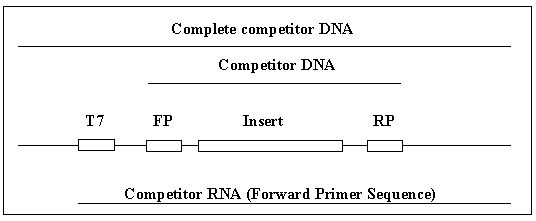
|
GENTAUR EUROPE BELGIUM1 tel +32 2 732 5688 fax +32 2 732 4414 [email protected] Av. de l' Armée 68 B-1040 Brussels France tel 01 43 25 01 50 fax 01 43 25 01 60 9, rue Lagrange 75005 Paris Italy tel 02 36 00 65 93 fax +32 16 50 90 45 20135 Milano Germany tel +32 16 58 90 45 fax +32 16 50 90 45 Forckenbeckstraße 6 D-52074 Aachen Japan tel +81 78 386 0860 fax +81 78 306 0296 Minaatojimaminami-manchi Chuo-ku, Kobe 065-0047 |
| PCR-CUCOs: Customised Competitors for Quantitative PCR and RT-PCR |
|
For the quantification of nucleic acids methods of competitive PCR using heterologous sequences for calibration are well established [1-4]. Now you can order customized heterologous competitive internal standards for quantitative PCR (Competitor DNA) [5] and quantitative RT-PCR (Competitor RNA) [6]. Serial dilutions of known quantities of competitor DNA (or RNA) are added to PCR- (or RT) reactions containing constant amounts of sample target. As both the competitor and your specific target are amplified by the same primers, they compete during the amplification reaction. PCR products are resolved by gel electrophoresis and the quantities of competitor and target PCR product are compared. The target amount can be determined from the competitor dilution in which the amount of competitor and target PCR product are equal. We recommend to select a competitor which is at least about 10% larger or smaller than your target PCR fragment. Various sizes of competitor molecules can be ordered to take care of your special requirements. You provide us with the sequence of the forward and the reverse primer for your quantitative (RT)-PCR experiment, and Mobidab manufactures your specific competitor of choice.
Example: Quantification of rat muscle fructose-1,6-bisphosphatase mRNA by competitive RT-PCR. Quantitative RT-PCR was performed using 20 ng of total RNA from rat muscle which were titrated with four different known amounts of the heterologous competitor RNA (2 x 10e4, 4 x 10e4, 6 x 10e4, 8 x 10e4 molecules, lanes 1 to 4), reverse transcribed and amplified. Competitor RNA was obtained by in vitro transcription from complete competitor DNA (Comp400 containing the binding sites for forward and reverse primer) usingT7 RNA polymerase. |

|
|

|
|
|
We recommend to
select a competitor which is at least about 10% larger or smaller than
your target PCR fragment. Various sizes of competitor molecules can be
ordered to take care of your special requirements.
You can choose from:
|
 |
|
|
The insert is
prokaryotic DNA with 50 % GC content, homogenously distributed. We recommend to select a competitor which is at least about 10% larger or smaller than your target PCR fragment.The following sizes are available: |
|
|
References: [1] Haberhausen, G, Pinsl, J, Kuhn, C, Markert-Hahn, C Comparative Study of Different Standardization Concepts in Quantitative Competitive Reverse Transcription-PCR Assays. Journal of Clinical Microbiology, 1998 March, p. 628-633, Vol. 36, No. 3 [2] Auboeuf D, Vidal H The use of the reverse transcription-competitive polymerase chain reaction to investigate the in vivo regulation of gene expression in small tissue samples. Anal Biochem 1997 Feb 15;245(2):141-8 [3] Vats A, Katayama H, Kim Y, Mauer M, Fish AJ, McGlennen, RC Modified Method for Competitive Reverse Transcription Polymerase Chain Reaction for Rapid and Automated Quantitation of Messenger RNA in Multiple Samples. Mol Diagn 1997 Dec;2(4):235-240 [4] Gopalakrishnan R, Morse MA, Lu J, Weghorst CM, Sabourin CL, Stoner GD, Murphy SE Expression of cytochrome P450 2A3 in rat esophagus: relevance to N-nitrosobenzylmethylamine. Carcinogenesis 1999 May;20(5):885-91 [5] Siebert PD, Larrick JW. PCR MIMICS: competitive DNA fragments for use as internal standards in quantitative PCR. Biotechniques 1993 Feb;14(2):244-9. [6] Borriello F, Lederer J Construction of quantitative RT-PCR MIMICs. Biotechniques 1995 Oct;19(4):580-2, 584 |

